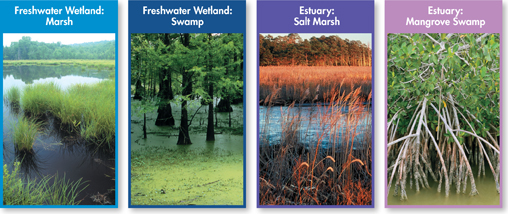Lakes and Ponds The food webs in lakes and ponds often are based on a combination of plankton and attached algae and plants. Plankton is a general term that includes both phytoplankton and zooplankton. Water typically flows in and out of lakes and ponds and circulates between the surface and the benthos during at least some seasons. This circulation distributes heat, oxygen, and nutrients.
Freshwater Wetlands A wetland is an ecosystem in which water either covers the soil or is present at or near the surface for at least part of the year. Water may flow through freshwater wetlands or stay in place. Wetlands are often nutrient-rich and highly productive, and they serve as breeding grounds for many organisms. Freshwater wetlands have important environmental functions: They purify water by filtering pollutants and help to prevent flooding by absorbing large amounts of water and slowly releasing it. Three main types of freshwater wetlands are freshwater bogs, freshwater marshes, and freshwater swamps. Saltwater wetlands are called estuaries.
Estuaries
 Why are estuaries so important?
Why are estuaries so important?
An estuary (es tyoo er ee) is a special kind of wetland, formed where a river meets the sea. Estuaries contain a mixture of fresh water and salt water, and are affected by the rise and fall of ocean tides. Many are shallow, which means that enough sunlight reaches the benthos to power photosynthesis. Estuaries support an astonishing amount of biomass—although they usually contain fewer species than freshwater or marine ecosystems—which makes them commercially valuable.  Estuaries serve as spawning and nursery grounds for many ecologically and commercially important fish and shellfish species including bluefish, striped bass, shrimp, and crabs.
Estuaries serve as spawning and nursery grounds for many ecologically and commercially important fish and shellfish species including bluefish, striped bass, shrimp, and crabs.
Salt marshes are temperate estuaries characterized by salt-tolerant grasses above the low-tide line and seagrasses below water. One of the largest salt marshes in America surrounds the Chesapeake Bay in Maryland (shown below). Mangrove swamps are tropical estuaries characterized by several species of salt-tolerant trees, collectively called mangroves. The largest mangrove area in America is in Florida's Everglades National Park (shown below).

Table of Contents
- Formulas and Equations
- Applying Formulas and Equations
- Mean, Median, and Mode
- Estimation
- Using Measurements in Calculations
- Effects of Measurement Errors
- Accuracy
- Precision
- Comparing Accuracy and Precision
- Significant Figures
- Calculating With Significant Figures
- Scientific Notation
- Calculating With Scientific Notation
- Dimensional Analysis
- Applying Dimensional Analysis




